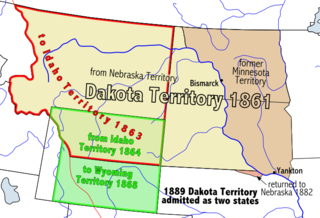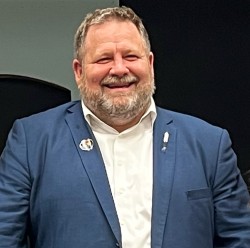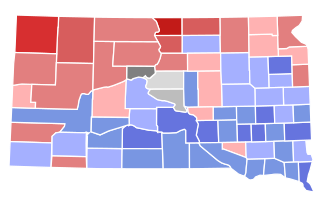Related Research Articles

South Dakota is a U.S. state in the North Central region of the United States. It is also part of the Great Plains. South Dakota is named after the Lakota and Dakota Sioux Native American tribes, who comprise a large portion of the population with nine reservations currently in the state and have historically dominated the territory. South Dakota is the seventeenth largest by area, but the 5th least populous, and the 5th least densely populated of the 50 United States. As the southern part of the former Dakota Territory, South Dakota became a state on November 2, 1889, simultaneously with North Dakota. They are the 39th and 40th states admitted to the union; President Benjamin Harrison shuffled the statehood papers before signing them so that no one could tell which became a state first. Pierre is the state capital, and Sioux Falls, with a population of about 192,200, is South Dakota's largest city.

Sioux Falls is the most populous city in the U.S. state of South Dakota and the 130th-most populous city in the United States. It is the county seat of Minnehaha County and also extends into Lincoln County to the south, which continues up to the Iowa state line. As of 2020, Sioux Falls had a population of 192,517, which was estimated in 2022 to have increased to 202,600. The Sioux Falls metro area accounts for more than 30% of the state's population. Chartered in 1856 on the banks of the Big Sioux River, the city is situated in the rolling hills at the junction of interstates 29 and 90.

The Territory of Dakota was an organized incorporated territory of the United States that existed from March 2, 1861, until November 2, 1889, when the final extent of the reduced territory was split and admitted to the Union as the states of North and South Dakota.

The Great Sioux Nation is the traditional political structure of the Sioux in North America. The peoples who speak the Sioux language are considered to be members of the Oceti Sakowin or Seven Council Fires. The seven-member communities are sometimes grouped into three regional/dialect sub-groups, but these mid-level identities are not politically institutionalized. The seven communities are all individual members of the historic confederacy. In contemporary culture, the designation is primarily a linguistic, cultural, and for some, political grouping.

The Rosebud Indian Reservation (RIR) is an Indian reservation in South Dakota, United States. It is the home of the federally recognized Sicangu Oyate – also known as Sicangu Lakota, and the Rosebud Sioux Tribe (RST), a branch of the Lakota people. The Lakota name Sicangu Oyate translates into English as "Burnt Thigh Nation"; the French term "Brulé Sioux" is also used.

Dennis Martin Daugaard is an American attorney and politician who served as the 32nd governor of South Dakota from 2011 to 2019. A member of the Republican Party, he was the first chief executive of a U.S. state to be the child of deaf parents. Before being elected governor, he was a lawyer, banker, development director for a nonprofit organization; he also served as a state senator from 1997 to 2003 and the 37th lieutenant governor of South Dakota from 2003 to 2011.
Frank M. Ziebach was a noted political figure in the Dakota Territory during the territorial period from 1861 to 1889. He was a pioneer newspaperman, founding a number of newspapers in the Iowa and Dakota Territories, including the Yankton "Weekly Dakotan" in 1861, which is still published today as the Yankton "Press and Dakotan". He was known as the "squatter governor" of the Dakota Territory. Ziebach County, South Dakota was created in 1911, and is named for him.
Steve Hickey is an American pastor and politician who served three terms in the South Dakota House of Representatives representing District 9, from 2011 to September 2015.

The 1892 South Dakota gubernatorial election was held on November 8, 1892. Incumbent Republican Governor Arthur C. Mellette declined to seek re-election to a third term. Former territorial legislator Charles H. Sheldon was nominated by the Republican Party as Mellette's replacement, and he faced former legislator Abraham Lincoln Van Osdel, a leader in the South Dakota Farmers' Alliance and the nominee of the Independent Party, along with Democratic nominee Peter Couchman, in the general election. The result was largely a replay of the 1890 election, with Sheldon winning by a large margin, but only a plurality, and Van Osdel taking second place over Couchman.

The 1904 South Dakota gubernatorial election was held on November 8, 1904. Incumbent Republican Governor Charles N. Herreid declined to run for re-election to a third term. Clark County State's Attorney Samuel H. Elrod won the Republican nomination to run as Herreid's successor, and he faced Democratic nominee Louis N. Crill, the former President of the State Senate, and former U.S. Congressman Freeman Knowles, the Socialist nominee. For the first time since 1894, the Democratic and Populist Parties nominated separate candidates. Ultimately, the split in the two parties did not prove dispositive; Elrod defeated Crill and the other candidates in a landslide.
This timeline of South Dakota is a list of events in the history of South Dakota by year.
James William Emery was an American politician. He served in the South Dakota House of Representatives in 1985 and in the Senate from 1986 to 1996. He is a Cheyenne River Sioux.

The 1932 United States Senate election in South Dakota took place on November 7, 1944. Incumbent Republican Senator Chan Gurney ran for re-election to a second term. He faced a strong challenge in the Republican primary from Lieutenant Governor A. C. Miller, who claimed that Gurney was too friendly to New Deal policies, but was defeated by Gurney by a wide margin. In the general election, Gurney faced former State Senator George M. Bradshaw, whom he defeated in a landslide as Thomas E. Dewey was decisively winning the state over President Franklin D. Roosevelt in the presidential election.
Sue Peterson is an American politician who sits in the South Dakota House of Representatives. A former banker and track coach, she is a member of the South Dakota Republican Party.

Jamie R. Smith is an American politician who serves as a member of the South Dakota House of Representatives. Smith represents District 15, which covers downtown neighborhoods, including areas around Terrace Park and the Great Plains Zoo, in Sioux Falls. He has served as House Minority Leader since the 2019 legislative session.

The 1926 South Dakota gubernatorial election was held on November 2, 1926. Incumbent Republican Governor Carl Gunderson ran for re-election to a second term. The election was largely a rematch of the 1924 election, with Gunderson's chief opponent from two years prior, Democrat William J. Bulow, challenging him once again. Two other candidates—Farmer–Labor nominee Tom Ayres and Pierre Mayor John E. Hipple, an independent—also ran. Though the left-leaning vote was split, Bulow was still able to win a decisive victory over Gunderson, whose support from two years earlier had completely collapsed.

The 1932 South Dakota gubernatorial election was held on November 8, 1932. Incumbent Republican Governor Warren Green ran for re-election to a second term. He defeated former Governor Carl Gunderson in the Republican primary and faced former State Representative Tom Berry, the Democratic nominee, in the general election. Aided by Democratic presidential nominee Franklin D. Roosevelt's landslide victory in South Dakota, Berry defeated Green for re-election in a landslide.

The 1934 South Dakota gubernatorial election was held on November 6, 1934. Incumbent Democratic Governor Tom Berry ran for re-election to a second term. After defeating an intra-party challenge from Lieutenant Governor Hans Ustrud, Berry faced magazine publisher William C. Allen, who won a crowded Republican primary with a large plurality. Aided by the national environment favoring Democrats, Berry won re-election in a landslide.

The 1938 South Dakota gubernatorial election was held on November 8, 1938. Incumbent Republican Governor Leslie Jensen declined to seek re-election and instead unsuccessfully ran for the U.S. Senate. Harlan J. Bushfield, the former Chairman of the South Dakota Republican Party, won the Republican primary to succeed Jensen. In the general election, he faced Democratic nominee Oscar Fosheim, a State Representative from Miner County, in the general election. Bushfield defeated Fosheim by a relatively close margin, winning his first term as governor.

The 1940 South Dakota gubernatorial election was held on November 5, 1940. Incumbent Republican Governor Harlan J. Bushfield sought re-election to a second term. After winning the Republican primary by a large margin, he faced Democrat Lewis W. Bicknell, former Day County State's Attorney, in the general election. Though Bushfield underperformed Republican presidential nominee Wendell Willkie, who won the state in a landslide, he nonetheless defeated Bicknell by a wide margin to easily win re-election.
References
- ↑ "South Dakota Legislature".
- ↑ Legislature, South Dakota (1987). "South Dakota Legislative Manual".
- ↑ Emogene Paulson, T.; Moses, Lloyd R. (1988). "Who's who Among the Sioux".